Yes, Ships from NY.Is this Nano bore cleaner available in the US..?
You are using an out of date browser. It may not display this or other websites correctly.
You should upgrade or use an alternative browser.
You should upgrade or use an alternative browser.
Lewis Lead Remover: What happened to it?
- Thread starter pokey074
- Start date
Jäger1
Member
At risk of being labeled a heretic and/or ignorant, you have another option. It's called plain old steel wool.Where are the Lewis/Brownells lead removers? I have a 629 that's leading pretty good and I'm tired of trying to get copper Chore Boy to work.
I spent my first 40 years of hunting and competitive shooting believing that only Bubba would shove steel wool down a barrel.
And then I got involved in the purchase of the carcass of the former Montana Rifle Company in an attempt to get it back up and running producing rifle barrels again. Among the first things I had to do as the ops manager was find former employees who had been laid off a few weeks prior when the owner group simply walked away from the business, got on their business jets, and flew home (to Florida for most of them).
To shorten the story a bit, these employees told me that they individually hand-lapped every single one of the barrels that went on MRC's quasi-custom rifles.
I found this claim intriguing as I have hand-lapped the barrels of a couple of rifles very special to me. In the version I learned, you create a lead lap and then go through the process of using increasingly finer grades of lapping compound until there are no loose spots anywhere in the bore and resistance to the lap being pushed through the bore is uniform from end to end.
So I went to the shop to watch this hand lapping they did to all barrel blanks. It consisted of clamping them five at a time in a fixture, then the employee took what looked like a stainless steel cleaning rod with a piece of shovel handle that would fit two hands on the end, and a wire brush wrapped with coarse steel wool at the other end. This got rammed back and forth through each of the barrels, with the employee having a squint down the barrels occasionally to see if he was satisfied as to whether or not the barrel was sufficiently cleaned of reamer marks to be considered good to go. The barrels were regularly checked with pin gauges while doing this.
I was a bit aghast to say the least.
So curiosity got the best of me and I decided that some experimental testing needed to be done if we were going to continue "hand lapping" of the barrels we would produce.
I went and found a barrel that had been scrapped due to a defect that resulted at some point during the drilling, reaming, and rifling process. I used the pin gauges to find the ID of the bore. Then I started doing their cross-fit version of "hand-lapping" with steel wool.
The finding was that it took a LOT of industrial strength scrubbing of that bore before I ultimately opened up that bore enough that the bore ID had increased .001". That was six years ago now, but if my memory is correct, it took over half an hour of scrubbing while checking with pin gauges before the bore ID increased that thou.
So while I haven't done anything since where one of my guns requires more than just normal cleaning, I would not hesitate to use steel wool now if I had a problem with leading in the bores of rifles I use mostly with cast bullets.
If you find this hard to believe, lay your hands on a scrap barrel and repeat this while checking during the process with pin gauges.
BTW, reviews of the MRC's rifles during their lifetime reported that their accuracy was well above average (if you trust gun magazine reviews of any firearm, of course).
As to why MRC adopted this "hand lapping" (identical to that done by the other barrel manufacturer in Kalispell), it was probably because they had allowed their Springfield Armory Pratt & Whitney gun drills and reamers to get into horrible mechanical shape by not doing regular maintenance as has to be done with any production lathe, milling machine, etc. Kind of like deciding you never have to change the oil in your truck, just keep running it.
Those Pratt & Whitneys had started out at Springfield Arsenal making barrels for US military weapons during WWI; the brass WWII arsenal tags were still mounted on the bases. They had been making barrels for the US military through two world wars, Korea, Vietnam, etc before being sold off as surplus. They were making 3,000 AR-15 barrels a day for Remington after they bought the barrel division off Brian Sipe for their AR-15s.
If I had known the sad things that were going to happen with the new company and what was going to happen with those drills, I would have taken those tags off them to add to my collection of interesting things. But all I have is pictures...



rpv-ak
Member
Don't use them on the exterior and front of the cylinders of blued, nickel-finished, and brush finished guns—even stainless steel. It has a grit rating of 200-300. I cut patches out of the and wrap soft brushes and well as using them on a jag tip.They work, but they will also remove blueing so be careful when using on blued guns.
John
If someone else has suggested this already, forgive me. I have a Lewis Lead remover, have for years, and found the simply cutting up a copper Chore Boy scouring pad, wrapping the cuttings around a bore-size brass brush, and going to work on a leaded bore (after a soaking application of your favorite cleaning solution) works better than anything else I have tried. Still occasionally use the Lewis for forcing cones. .
Similar threads
- Replies
- 2
- Views
- 733
- Replies
- 10
- Views
- 1K
- Replies
- 8
- Views
- 366
